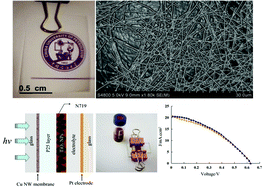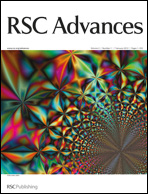Rapid and large-scale synthesis of Cu nanowires via a continuous flow solvothermal process and its application in dye-sensitized solar cells (DSSCs)†
Abstract
Single crystalline copper nanowires with pentagonal cross sections and large aspect ratios have been successfully prepared in high yield via a continuous flow solvothermal reduction process at a low temperature. The highly crystalline filaments exhibit the face-centered cubic structure, growing mainly along the [110] direction. Both PVP and the solvent environment play an important role for the growth of nanowires. The growth mechanism has been properly discussed. We also report the flexible transparent Cu nanowire membrane electrode fabricated by coating a polymer layer as a potential replacement for the conventional FTO electrode in dye-sensitized solar cells (DSSCs). Fabricated CuNW membranes exhibit high optical transmittance and electrical conductance, which can be controlled via the synthesis process, conveniently. The efficiency of a DSSC with CuNWs increases upto 5%. The DSSC performs as well as with a FTO electrode, which indicates that the super-high aspect ratio of the Cu nanowires offers a range of electrical transport routes to connect dye loaded photo-anodes, and such an electrode has the potential to replace conventional FTO electrodes for low-cost DSSCs applications.


 Please wait while we load your content...
Please wait while we load your content...